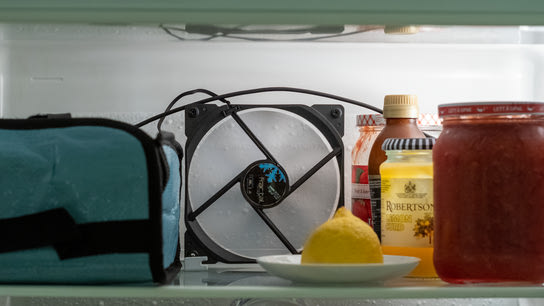I’ve installed a small 120 cm 12-volt air circulation fan in my aging Electrolux combo fridge-freezer. It’s just a cheap PC fan, available everywhere. The upgrade resulted in more stable temperatures and a 29 % reduction in power consumption.
Many modern refrigerators come with a small fan built-in to improve air circulation inside the cooling box. My ten-year-old Electrolux combo unit doesn’t have such modern luxuries. It had to operate with the temperature control dial at about 85 %-effect and saw large temperature fluctuations.
After installing the fan in the fridge, I could turn down the temperature control dial to about 45 %-effect. This reduced the daily power consumption from 2,09 kWh/d to 1,47 kWh/d.
In monetary terms, that’s a utility bill savings of roughly 22 euro/year. The fan-project cost 17,50 euros and should pay for itself in the first 10 months.
The fridge’s energy classification says it’s only supposed to use 0,9 kWh/d at this setting. It’s an aging unit and it’s built into the kitchen so air-circulation around it certainly isn’t a best-case situation.
The most important benefit to me was how the fan helped improve and stabilize the temperatures in the refrigerator. The temperature is now 4–6℃ at the top and the bottom shelves. Without the fan, the refrigerator would vary from -1–9℃ at bottom shelf and 6–13℃ on the top shelf.
I store temperature-sensitive medication (insulin) in my refrigerator. (The bag to the left in the photo.) It absolutely must not freeze and degrades quickly when it’s stored above the ideal temperature range.
As a nice bonus, the fridge compressor won’t need to run nearly as long at a time. Thereby lowering the noise level as well as the heat exchanged from the refrigerator into my apartment. The removed heat effect is approximate to not running a standard 900-watt fan-heater for 37 minutes every day.
In the do-it-yourself spirit, here are the components I used:
| Part | Price |
|---|---|
| Fractal Silent 120cm 12V fan | 9,00 euro |
| USB step-up converter board | 1,50 euro |
| 5V USB power supply w/cable | 6,00 euro |
| A small plastic box | < 1,00 euro |
| Two PCI slot cover guards | |
| Two zip-ties |
The set up is really straight-forward. The fan’s power cables are soldered on to the step-up converter. The step-up converter is used to convert 5V from the USB power supply up nearer to the 12V the fan needs. It also lets me adjust the fan’s speed.
The step-up converter is placed inside a small re-purposed glucose test strip box with holes on the top and bottom for the wires. This step is optional, but it protects it against accidental short circuits and moisture. It also increases the project’s partner-approval rating.
The fan is kept upright using feet made from zip-tied PCI slot cover brackets re-purposed from my computer chassis. You can use just about anything you want to keep the fan upright, of course.
The USB power cable goes from the step-up converter out through the door seal and into the USB power supply connected to a wall outlet outside the fridge. I checked the seal with an IR-thermometer and couldn’t detect any cold air leaking out around the cable.
This set up is not finger- or child-friendly. You can fasten the fan and wires more securely, and install a fan-guard shield to help with that. Installing everything in a box with air intake and outlets can also work.
The main difference from my setup and the ones that come built-in to refrigerators is that those automatically switch off when you open the door to keep the cold air in. My DIY set up instead accelerates the cold air’s escape from the refrigerator when the door is opened.
You can find manufactured battery-powered versions of this ideal designed for RV-mini-refrigerators. I wasn’t really interested in this solution, though. I didn’t want to swap out the batteries in my fridge fan every few weeks.
The power consumption and temperature measurements used for comparisons in this article were performed over twelve weeks.
